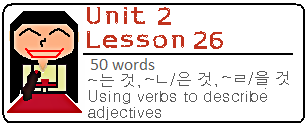 Description
Description
You have known for a long time how to describe nouns with adjectives. In this lesson, you will be introduced to the very important ~는 것 principle. Using this, you will be able to describe nouns with verbs – as in “the man who is running.” Pay attention, because the concepts you learn in this lesson will be the base for the next 5 – 6 lessons!
This Lesson is also available in Deutsch, Русский and Suomi.
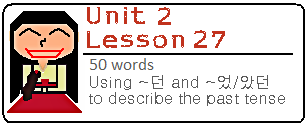 Description
Description
In this lesson, you will add to what you learned in Lesson 26 by learning more about the ~는 것 principle. Specifically, you will learn about how to use ~던/었던 to describe nouns in the past tense using verbs and adjectives. You will also see how these can be similar to ~은 것.
This Lesson is also available in Русский and Español
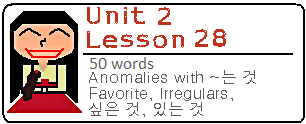 Description
DescriptionIn this lesson, you will learn a lot of weird things about ~는 것 that don’t really make sense. Here, you will learn thing that are counter-intuitive, but still very important to know about this principle. For example, you will learn about irregular conjugations, saying “my favorite thing” and other small things that you wouldn’t expect.
This Lesson is also available in Русский and Español
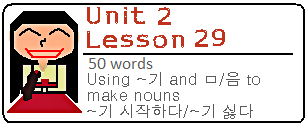 Description
DescriptionIn this lesson, you will learn how to use ~기 and ~ㅁ/음 to make nouns from verbs or adjectives. These work very similarly to the ~는 것 principle, but there are some differences you should be aware of.
This Lesson is also available in Русский and Español
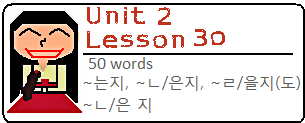 Description
Description
In this lesson, you will learn how to add ~는지, ~ㄴ/은지 and ~ㄹ/을지(도) to sentences to express uncertainty. Then, you will learn how to indicate that you have been doing something for a certain amount of time.
This Lesson is also available in Русский and Español
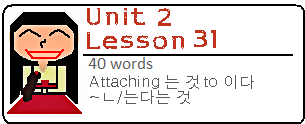 Description
DescriptionIn previous lessons, you learned how to add ~는 것 to verbs (and adjectives). In this lesson, you will learn about how to apply ~는 것 to 이다.
This Lesson is also available in Español and Русский
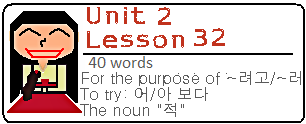 Description
DescriptionIn this lesson, you will learn about how to use ~려고 and ~러 in sentences to have the meaning of “for the purpose of/in order to.” You will also learn how to add ~어/아 보다 to verbs to have the meaning of “attempt/try to,” which is often used with the noun ‘적.’
This Lesson is also available in Español and Русский
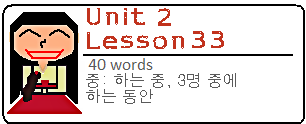 Description
DescriptionIn this lesson, you will learn two common ways to use the noun ‘중’ in Korean. You will learn how to place 중 after a verb with ~는 것 to have the meaning of “I am ___ing.” You will also learn how to place it after multiple nouns to have the meaning of “..of all ___.”
This Lesson is also available in Español and Русский
______________________________
Lessons 26 – 33 Mini Test
______________________________
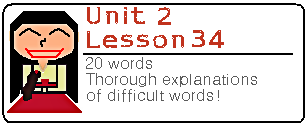 Description
Description
In this lesson, you will learn some difficult words and concepts in Korean that I couldn’t fit into any particular lesson. Specifically, you will learn how to to use: 자기/자신, 훨씬, 관하다/관련하다, 주위, 일단, 전혀/별로, words dealing with weight, and words ending in ~거리다.
This Lesson is also available in Español and Русский
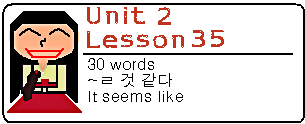 Description
DescriptionIn this lesson, you will learn how to use the common Korean ending of ~ㄹ 것 같다. You can use this ending to express “this MIGHT be/this SEEMS to be.” In addition, you will learn how to use this ending with the common phrase “그럴 것 같다.”
This Lesson is also available in Español and Русский
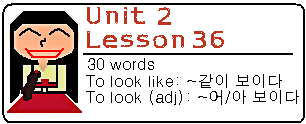 Description
DescriptionIn this lesson, you will learn how to use ~같이 보이다 to say that something/somebody looks like something. For example, “You look like a monkey!” The same pattern can be used to say that something smells/tastes like something. For example, “You smell like a monkey!” In addition, you will learn how to use ~어/아 보이다 to say that somebody looks like an adjective – for example “You look happy!”
This Lesson is also available in Español and Русский
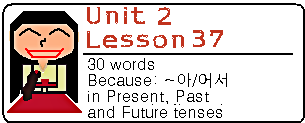 Description
DescriptionIn this lesson, you will learn how to add ~아/어서 to the stems of verbs/adjectives to have the meaning of “because/therefore.” In English, we just have a word for “because” but in Korean, it actually a grammatical concept. Using this concept will make your sentences much more complex and natural because you will now be able to say things like “I want to eat
because I am hungry.”
This Lesson is also available in Español
 Description
DescriptionIn the previous lesson, you learned how to add ~아/어서 to words to create the meaning of “because/therefore…” In this lesson, you will learn how to create this name meaning, but using a different grammatical concept: ~기 때문에. You will learn how to apply this to future, past and present tenses, as well as how you can use 때문에 in other situations.
This Lesson is also available in Español
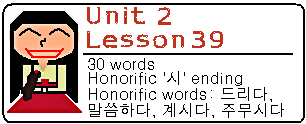 Description
DescriptionIn this lesson, you will learn how to add the honorific ‘시’ ending to word stems to express respect to the acting agent in a sentence. In addition, you will learn some common words that do not need this honorific ending because they themselves imply respect. Word such as: 드리다, 말씀하다, 계시다, 들다, etc…
This Lesson is also available in Español
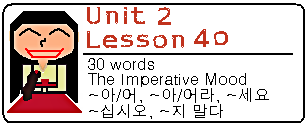 Description
DescriptionIn this lesson, you will learn about the imperative mood in Korean, which is a fancy way to say “giving commands.” This is one of the most important lessons we have had in a while, so study this one hard! You will learn the endings that you can use to make commands, such as ~세요, ~아/어, ~아/어라 and others with the same meaning. In addition, you will learn how to use the imperative mood in negative sentences as well, to create sentences like “Don’t go to the park!”
This Lesson is also available in Español
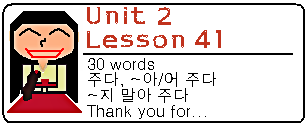 Description
DescriptionIn this lesson, you will learn all about the word 주다! Using what you learned from Lesson 40, you will learn how to add the imperative endings (~세요, 아/어, etc) to 주다 to tell people to give you things. You will also learn how to attach 주다 to verbs/adjectives tell people to do things using 아/어 주다.
This Lesson is also available in Español
______________________________
Lessons 34 – 41 Mini Test
______________________________
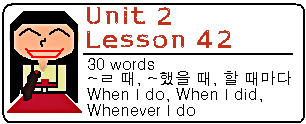
Description
In this lesson, you will learn how to say “When I…” by adding ~ㄹ 때 to words. By using this form, you can make sentences like “When I go to Korea, I will study Korean.” You will also learn how to use this form in the past tense and also how to say “Whenever I…”
This Lesson is also available in Español
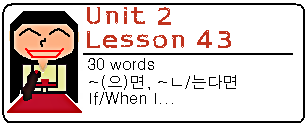 Description
DescriptionIn this lesson, you will learn how to say “if” and “when” by using ~(으)면 or ~ㄴ/는다면.
This Lesson is also available in Español
 Description
Description
In this lesson, you will learn about ~자 and ~ㅂ/읍시다, which are two common endings that you can use to suggest that you do something with another person. In addition, you will learn how to use ~ㄹ래(요) which can sometimes be used in similar situations.
This Lesson is also available in Español
 Description
DescriptionIn this lesson, you will learn how to add ~ㄹ 수 있다 and ~ㄹ 수 없다 to the ends of words to create the meaning of “I can” and “I can’t.”
This Lesson is also available in Español
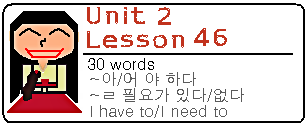 Description
DescriptionIn this lesson, you will learn how to say “I have to” and “I need to” using two grammatical principles. By using ~아/어 야 하다, you can create the meaning of “I have to” and by using ~ㄹ 필요가 있다 to say “I need to.”
This Lesson is also available in Español
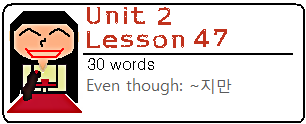 Description
Description
In this lesson, you will learn how to use ~지만 to connect two clauses. You will also learn about adding this to 그렇다 to make그렇지만.
This Lesson is also available in Español
 Description
Description
In this lesson, you will learn how to use ~아/어도 to connect two clauses. You will also learn about adding this to 그렇다 to make그래도 and about the word 아무리.
This Lesson is also available in Español
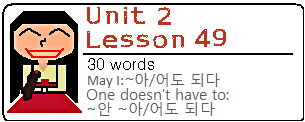 Description
Description
In this lesson, you will build on your understanding of ~아/어도 to make sentences using 되다. Using these concepts, you will be able to indicate that here is no problem if something is or is not done.
This Lesson is also available in Español
 Description
DescriptionIn this lesson, you will learn how to add three nouns (예정, 계획 and 준비) after the future-tense construction of ~는 것 – ~ㄹ/을 것. By using these three nouns after this grammatical formation, you will be able to say a wide variety of common sentences.
This Lesson is also available in Español
______________________________
Lessons 42 – 50 Mini Test
______________________________
Unit 2 Test
______________________________
 Description
Description Description
Description Description
Description Description
Description Description
Description Description
Description Description
Description Description
Description Description
Description Description
Description Description
Description Description
Description Description
Description Description
Description Description
Description Description
Description Description
Description








